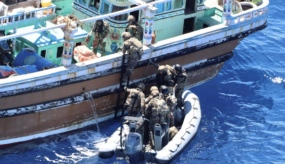Posted on 17 Jan 2018
The UNPoA is being revised this year. It is crucial for Africa to make the most of this opportunity.
This year, Africa faces an important opportunity to make its voice heard on the future of the key global instruments concerning the illicit circulation of small arms and light weapons (SALW).
This opportunity will arise at the third review conference (referred to as RevCon3) of the United Nations Programme of Action to Prevent, Combat and Eradicate the Illicit Trade in Small Arms and Light Weapons in all its Aspects (UNPoA) and its International Tracing Instrument (ITI).
The UNPoA is a global instrument for activities that counter illicit trade in SALW and mitigate the negative consequences of these weapons. The ITI ‘requires states to ensure that weapons are properly marked and that records are kept’ and provides a framework for cooperation in weapons tracing.
The objective of the review, which has taken place every six years since the adoption of the UNPoA, is to assess the progress made in implementing these instruments. This third review aims to break new ground and pave the way for the future implementation of the UNPoA and the ITI.
Africa is affected gravely by the illicit circulation of SALW. Accordingly, RevCon3 is an important opportunity for the continent raise its voice and ensure its priorities, challenges and realities are adequately reflected.
In preparation for RevCon3 and to support member states in reaching concrete, forward-looking outcomes, the UN Office of Disarmament Affairs (UNODA) and the Small Arms Survey have organised a series of symposia that will carry on into early 2018, as was stated by the UN High Representative for Disarmament Affairs.
Three of the symposia were held in 2017: two at the UN in New York in October and one at the UN in Geneva in November.
The themes of the symposia highlight areas of key importance for the future development and implementation of the UNPoA and ITI. The first New York symposium concentrated on ‘Small arms and light weapons tracing and stockpile management in conflict and post-conflict situations’, and the second on ‘Small arms and light weapons and the 2030 Agenda for Sustainable Development, including Sustainable Development Goal 16 [SDG 16] and the gender aspects of SALW control.’
SDG 16 broadly calls for the promotion of peaceful and inclusive societies for sustainable development, the provision of access to justice for all and building effective, accountable institutions at all levels. Target 16.4 further urges countries to, ‘…by 2030, significantly reduce illicit financial and arms flows, strengthen the recovery and return of stolen assets and combat all forms of organized crime.’
The New York symposia also highlighted the complementarity between regional-level and national-level indicators for measuring Target 16.4.
In her keynote address at the opening of the first New York symposium, Izumi Nakamitsu, the UN High Representative for Disarmament Affairs, underscored the importance of the UNPoA and ITI, explaining that 2016 had marked 10 years of deterioration in peace. She added that terrorism was more prevalent than ever, that conflict-related deaths were at a 25 year-high and that the number of refugees and displaced people was the highest it had been since World War II.
Illicit guns, she added, ‘…threaten electoral processes, undermine police authority, and deeply harm peacekeeping. They facilitate sexual violence and the recruitment of child soldiers.
‘Armed violence makes public health costs soar. And armed insecurity is the number one reason that businesses decide not to invest in a country.’ The economic impact of violence on the world economy, she said, amounted to US$13.6 trillion in 2015 – about 11 times more than global foreign investment.
The Geneva symposium, on the other hand, emphasised synergies between the UNPoA, the Arms Trade Treaty (ATT) and other relevant instruments, including the UN Firearms Protocol and UN counter-terrorism mechanisms.
Some of the major issues of relevance to Africa that emerged from all three symposia relate to whether the RevCon3 should set up controls on the artisanal manufacture of arms, a prominent practice in parts of Africa.
Another area of interest was how capacity can be boosted for collecting data in countries using indicators linked to Target 16.4, including how this data could be interpreted and used. Doing this would require resources and technical expertise. It would therefore be in Africa’s interest to come up with a common policy on these issues and make concrete proposals at the RevCon3.
A general assessment of current efforts in Africa to combat the illicit trade in SALW shows a continent that has sufficiently taken stock of the realities and challenges it faces. For instance, Africa’s existing regional economic communities (RECs) and regional mechanisms (RMs) have developed legally binding instruments on SALW, in support of the UNPoA, ITI and other global instruments. Research by ENACT has elucidated further some of these achievements.
Of equal importance is the realisation by the African Union Commission, the RECs and RMs that more action needs to be taken. As preparation for RevCon3 continues, Africa needs to speak with a strong and united voice on the continent’s priorities in an African common statement. African states must urgently caucus on this important contribution to ensure that the new face of the UNPoA remedies the persistent scourge of illicit arms flows in Africa.



